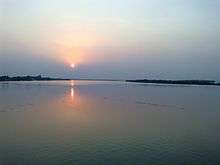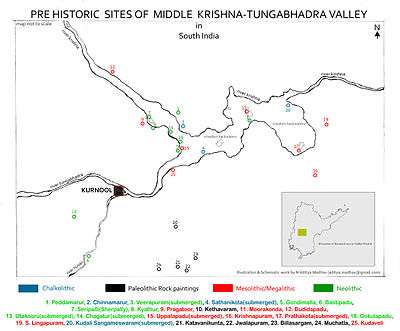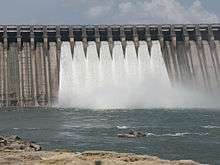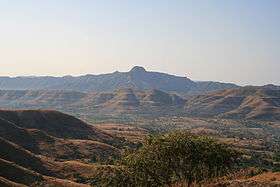Krishna River
| Krishna | |
| కృష్ణా నది, कृष्णा नदी, ಕೃಷ್ಣಾ ನದಿ | |
 | |
| Country | India |
|---|---|
| States | Maharashtra, Karnataka, Telangana, Andhra Pradesh |
| Tributaries | |
| - left | Bhima, Dindi, Peddavagu, Halia, Musi, Paleru, Munneru |
| - right | Venna, Koyna, Panchganga, Dudhaganga, Ghataprabha, Malaprabha, Tungabhadra |
| Source | Near Mahabaleswar, Jor village |
| - location | Satara district, Maharashtra, India |
| - elevation | 914 m (2,999 ft) Geographic headwaters |
| - coordinates | 17°59′18.8″N 73°38′16.7″E / 17.988556°N 73.637972°E |
| Mouth | Hamsaladeevi, Krishna district, Andhra Pradesh |
| - location | Bay Of Bengal, India |
| - elevation | 0 m (0 ft) |
| - coordinates | 15°44′10.8″N 80°55′12.1″E / 15.736333°N 80.920028°ECoordinates: 15°44′10.8″N 80°55′12.1″E / 15.736333°N 80.920028°E [1] |
| Length | 1,400 km (870 mi) approx. |
| Basin | 258,948 km2 (99,980 sq mi) |
| Discharge | |
| - average | 2,213 m3/s (78,151 cu ft/s) [2] |
| Discharge elsewhere (average) | |
| - Vijayawada (1901–1979 average), max (2009), min (1997) |
1,641.74 m3/s (57,978 cu ft/s) |
 Path of the Krishna through the South Indian Peninsula
| |


The Krishna River is the fourth biggest river in terms of water inflows and river basin area in India, after the Ganges, Godavari and Brahmaputra. The river is almost 1,300 kilometres (810 mi) long. The river is also called Krishnaveni. It is a major source of irrigation for Maharashtra, Karnataka, Telangana and Andhra Pradesh.[3]
Sources
Krishna river originates in the western ghats near Mahabaleshwar at an elevation of about 1,300 meter, in the state of Maharashtra in central India. It is one of the longest rivers in India. The Krishna river is around 1,290 km in length. The Krishna river's source is at Mahabaleswar near the Jor village in the extreme north of Wai Taluka, Satara District, Maharashtra in the west and empties into the Bay of Bengal at Hamasaladeevi (near Koduru) in Andhra Pradesh, on the east coast. It flows through the state of Karnataka before entering Telangana State. The delta of this river is one of the most fertile regions in India and was the home to ancient Satavahana and Ikshvaku Sun Dynasty kings. Vijayawada is the largest city on the River Krishna.
It causes heavy soil erosion during the monsoon floods. It flows fast and furious, often reaching depths of over 75 feet (23 m). Ironically, there is a saying in Marathi (language of Maharashtra) "Santh vaahate Krishnamaai" which means "quiet flows Krishna". This term is used to describe that a person should be as quiet as Krishna.
Tributaries


The largest tributary of the Krishna River is the Tungabhadra with a drainage basin measuring 71,417 km2 running for about 531 km but the longest tributary is the Bhima which makes a total run of 861 km and has an equally large drainage area of 70,614 km2.
There are four rivers that join the Krishna at a confluence known as Preeti Sangam, or "Lover's Meeting Point" in the Satara District. These are Venna river, Urmodi River, Tarli River and Koyna river.
Three tributaries meet Krishna river near Sangli. These places are very holy. It is said that Lord Dattatreya spent some of his days at Audumber on the banks of river Krishna. Sangameswaram of Kurnool district in Andhra Pradesh is a famous pilgrim center for Hindus where Tungabhadra and Bhavanasi rivers join the Krishna river. The Sangameswaram temple is now drowned in the Srisailam reservoir, and visible for devotees only during summer when the reservoir's water level comes down[4]
| Right-bank tributary | Town, District, State of confluence | Left-Bank Tributary |
|---|---|---|
| Venna River | Sangam Mauli, Satara, Maharashtra | |
| Urmodi river | Kashil, Satara, Maharashtra | |
| Tarali/Kali Ganga river | Umbraj, Satara, Maharashtra | |
| Mand river | Umbraj, Satara, Maharashtra | |
| Tasawade, Satara, Maharashtra | Kolamba river | |
| Koyna River | Karad, Satara, Maharashtra | |
| Bramhanal, Sangli, Maharashtra | Yerla river | |
| Warna River | Haripur, Sangli, Maharashtra | |
| Panchganga River | Narsobawadi, Sangli, Mahrashtra | |
| Dudhaganga | Yadur, Belgaum, Karnataka | |
| Hippagiri barrage | ||
| Ghataprabha River | Almatti, Bagalkot District, Karanataka | |
| Almatti Dam | ||
| Malaprabha River | Kudala Sangam, Bagalkot District, Karanataka | |
| Basava Sagar Reservoir | ||
| Ammapur, Kalburgi, Karnataka | Doni River | |
| Kadlur, Raichur, Karnataka | Bhima River | |
| Jurala dam | ||
| Lower Jurala dam | ||
| Tungabhadra River | Alampur, Mahaboobnagar, Telangana | |
| Srisailam temple | Srisailam Dam | |
| Nalgonda district, Telangana | Dindi River | |
| Nagarjuna Sagar dam | ||
| Chityal, Nalgonda | Halia River | |
| Nagarjuna Sagar tail pond dam | ||
| Wazirabad, Nalgonda, Telangana | Musi River | |
| Pulichintala dam | ||
| Mukteswarapuram, Krishna district | Paleru River | |
| Amaravathi village, Guntur district | Munneru River | |
| Ibrahimpatnam, Krishna district | Polavaram right bank canal | |
| Kondaveeti vagu | Ibrahimpatnam, Krishna district | Budameru diversion channel |
| Amaravati city | Prakasam Barrage | Vijayawada city |
| National Waterway 4 | Prakasam Barrage | National Waterway 4 |
Krishna Basin
Drainage Basin of Krishna
Krishna Basin extends over an area of 258,948 square kilometres (99,980 sq mi) which is nearly 8% of the total geographical area of the country. This large basin lies in the states of Karnataka (113,21 km2), Telangana, Andhra Pradesh (76,252 km2) and Maharashtra (69,425 km2).[5]
The Krishna river rises in the Western Ghats, at an elevation of about 1337 m just north of Mahabaleshwar, about 64 km from the Arabian Sea. It flows for about 1400 km and outfalls into the Bay of Bengal. The principal tributaries joining Krishna are the Ghataprabha, the Malaprabha, the Bhima, the Tungabhadra and the Musi.
Most of this basin comprises rolling and undulating country, except for the western border, which is formed by an unbroken line of the Western Ghats. The important soil types found in the basin are black soils, red soils, laterite and lateritic soils, alluvium, mixed soils, red and black soils and saline and alkaline soils.
An average annual surface water potential of 78.1 km³ has been assessed in this basin. Out of this, 58.0 km³ is utilisable water.[6] Culturable area in the basin is about 203,000 km2, which is 10.4% of the total culturable area of the country. As the water availability in the Krishna river is becoming inadequate to meet the water demand, main Godavari river is linked to the main Krishna river by commissioning the Polavaram right bank canal with the help of Pattiseema lift scheme in the year 2015 to augment water availability to the Prakasam Barrage in Andhra Pradesh. The irrigation canals of Prakasam Barrage form part of National Waterway 4.
Mullayanagiri peak, in Karnataka, is the highest point (1,930 m msl) of the Krishna basin.
Places and temples

This river is revered by Hindus as sacred. The river is also believed to remove all sins of people by taking a bath in this river. The centre of attraction is the Krishna Pushkaram fair which is held one in twelve years on the banks of the Krishna river. There are many pilgrimage places in Maharashtra, Karnataka, Telangana and Andhra Pradesh on the course of the river.
The first holy place on the river Krishna is "Dakshin Kashi Wai", known for the Mahaganpati Mandir and Kashivishweshwar temple. It has seven ghats along the river. Temples like Dattadeva temple, which is revered by the people of Maharashtra, are located on the banks of Krishna at Nrusinha Waadi and Audumbar near Sangli. Also, located on the banks of the river Krishna are the Sangameshwar Shiva temple at Haripur, goddess Durga temple in Vijayawada and Ramling temple near Sangli, Mallikarjuna temple (Srisailam), Amareshwara Swamy temple (Amaravati (state capital)), Dattadeva temple, Sangameshwara Shiva temples at Alampur in Telangana, Ramling temple, etc. as well as, villages such as Jihe.
Flora and Fauna
Wide spread area near to the Krishna river holds the rich flora and fauna. The last surviving Mangrove forests in the Krishna estuary have been declared as the Krishna Wildlife Sanctuary. The sanctuary is the home to the large number of resident and migratory birds. Fishing cat, otter, Estuarine crocodile, spotted deer, sambar, black buck, snake, lizards and jackal can also be spotted in the sanctuary. The sanctuary also supports rich vegetation with plants like Rhizophora, Avicennia, and Aegiceros. The following are few other wildlife sanctuaries located in the river basin.
- Nagarjunsagar-Srisailam Tiger Reserve
- Rollapadu Wildlife Sanctuary
- Bhadra Wildlife Sanctuary
- Ghataprabha Bird Sanctuary
- Gudavi Bird Sanctuary
- Koyna Wildlife Sanctuary
- Radhanagari Wildlife Sanctuary
- Great Indian Bustard Sanctuary
- Chandoli National Park
- Kudremukh National Park
- Kasu Brahmananda Reddy National Park
- Mahavir Harina Vanasthali National Park
- Mrugavani National Park
- Pakhal Wildlife Sanctuary
- Ranibennur Blackbuck Sanctuary
- Shettihalli Wildlife Sanctuary
- Daroji Sloth Bear Sanctuary, Bellary
Waterfalls

Manikyadhara Falls is located in Chikkamagaluru Taluk of Karnataka. It is formed by the water flowing from the slopes of Mullayanagiri peak which is the highest peak between the Himalayas and the Nilgiris. Barkana Falls is located in Agumbe hills which receives second highest average annual rainfall (7,624.3 mm) in India. The following are few other waterfalls located in the river basin
Bridges
The Krishna River is spanned by several bridges along its course, some of which are listed below.
- Krishna Bridge, Wai, Maharashtra – This bridge, which is located in the Dharmpuri Peth area of the town of Wai, is one of the oldest bridges that were built by the British in India. It spans the Krishna over nine kamans (arches) and is made of black rock. The bridge serves as a flood mark (when the water rises to the level of the road on the bridge) for the "Waikar" people.
- Irwin Bridge, Sangli – This is one of the oldest, historic and largest bridges over the Krishna that were built by the British. The Irwin Bridge, which is built of reddish stone, has two passages where one can climb down to the river in the middle of its span to view the water.
- B. Soundatti Bridge, Raibag – This is also one of the oldest bridges built during the British rule. This bridge connects Maharashtra to Karnataka state.
- Tangadagi Bridge, This is one of oldest bridge that connects the Bijapur and Bagalkot Districts of Karnataka. God Neelambika Temple is there at the bank of Krishna River.
Floods
In October 2009, heavy floods occurred, isolating 350 villages and leaving millions homeless,[7] which is believed to be first occurrence in 1000 years. The flood resulted in heavy damage to Kurnool, Mahabubnagar, Guntur, Krishna and Nalagonda Districts. The entire city of Kurnool was immersed in approximately 10 feet (3.0 m) water for nearly 3 days.[8]
Water inflow of 1,110,000 cu ft/s (31,000 m3/s) was recorded at the Prakasam Barriage, which surpassed the previous record of 1,080,000 cu ft/s (31,000 m3/s) recorded in the year 1903.[9]
Interstate water sharing
At present, the award of Bachawat tribunal dated 31 May 1976 is applicable for sharing the water available in the river among the riparian states. The Brijesh Kumar tribunal award given on 29 November 2013 is challenged by Andhra Pradesh in the Supreme Court and the case pending since then.[10] Newly created Telangana state also approached Supreme Court demanding a fresh tribunal hearing to secure its water needs on equitable basis.[11]
Dams

There are many dams constructed across the Krishna river.[12]
Hydroelectric power stations
Krishna river is one of the rivers whose water energy is harnessed to a large extent by various hydro electric power stations in India.[13] The following is the list of hydro electric power stations excluding small and medium installations.
- Koyna Hydroelectric Project, 1920 MW #
- Mulshi Dam, 300 MW #
- Thokarwadi Dam, 72 MW
- Ujjani Dam, 12 MW #
- Almatti Dam, 290 MW
- Bhadra Dam, 39 MW
- Tungabhadra Dam, 127 MW
- Jurala Hydroelectric Project, 240 MW
- Lower Jurala Hydro Electric Project, 240 MW
- Srisailam Dam, 1670 MW #
- Nagarjuna Sagar Dam, 960 MW #
- Nagarjuna Sagar tail pond, 50 MW
- Pulichinthala Dam, 120 MW.
#Power stations with Pumped-storage hydroelectricity units
Mineral deposits
Krishna river basin is endowed with rich mineral deposits such as oil & gas, coal, iron, lime stone, dolomite, gold, granite, laterite, uranium, diamonds, etc. The following are the few noted deposits:
- Krishna Godavari Basin, oil & gas
- Yellandu, coal
- Bayyaram Mines, iron
- Kudremukh, iron
- Donimalai, iron
- Jaggayapeta mines, dolomite
- Nalgonda uranium deposits,
- Kollur Mine, diamonds
- Hatti Gold Mines,
Pollution

River Krishna is on the verge of death.[14] Most of the years, the river water is not joining the sea due to full utilisation of water mainly in agriculture.[15][16] The river receives the waste from the large number of cities and the river basin population has increased to 80 million enhancing pollution load many folds in to the river. Adequate average and minimum continuous environmental flows to the sea are not taking place in most of the years constricting salt export and leading to formation of saline and sodic alkaline soils in the lower reaches of the river basin.[17][18] High alkalinity water is discharged from the ash dump areas of many coal fired power stations in to the river which further increases the alkalinity of the river water whose water is naturally of high alkalinity since the river basin is draining vast area of basalt rock formations.[19] The following are the few coal fired power stations located in the river basin:
- Vijayawada Thermal Power Station, 1,760 MW
- Raichur Thermal Power Station, 1,470 MW
- Bellary Thermal Power station, 1,000 MW
- Yermarus Thermal Power Station, 1,600 MW
- Solapur Super Thermal Power Station, 1,320 MW.
- Kudgi Super Thermal Power Project, 2,400 MW
- Yadadri Super Thermal Power Project, 7,500 MW
See also
|
|
References
- ↑ Krishna at GEOnet Names Server
- ↑ Kumar, Rakesh; Singh, R.D.; Sharma, K.D. (2005-09-10). "Water Resources of India" (PDF). Current Science (Bangalore: Current Science Association) 89 (5): 794–811. Retrieved 2013-10-13.
- ↑ "Map of Krishna River basin" (PDF). Retrieved 27 March 2015.
- ↑ Srisailam project manual
- ↑ "Krishna basin status report, March 2014" (PDF). Retrieved 27 March 2015.
- ↑ IWMI Research Report 83. "Spatial variation in water supply and demand across river basins of India" (PDF). Retrieved 23 June 2015.
- ↑ "Flooding along the Krishna River: Natural Hazards". earthobservatory.nasa.gov. Retrieved 11 October 2009.
- ↑ "Agony of Floods: Flood Induced Water Conflicts in lndia [sic]" (PDF). Retrieved 8 February 2016.
- ↑ "Managing historic flood in the Krishna river basin in the year 2009". Retrieved 11 October 2015.
- ↑ Hindu daily dated. "Court: do not publish KWDT-II decision". Retrieved 5 November 2012.
- ↑ "T-State wants tribunal to adjudicate water disputes". Retrieved 12 July 2014.
- ↑ "Headworks (Dam, Barrage,Weir, Anicut, Lift)". Retrieved 27 March 2015.
- ↑ "Power Houses in Krishna Basin". Retrieved 27 March 2015.
- ↑ "River Water Quality & Environmental Factors". Retrieved 25 August 2015.
- ↑ J. Keller, A. Keller and G. Davids. "River basin development phases and implications of closure" (PDF). Retrieved 25 August 2012.
- ↑ "IWMI Research report nos # 1, 3, 14, 56, 72, 83, 107, 111, 121, 123, 125 etc.". Retrieved 25 August 2015.
- ↑ Oregon State University, USA. "Managing irrigation water quality" (PDF). Retrieved 28 August 2012.
- ↑ "Alkalinity and salinity bane of soil in T state". Retrieved 23 October 2015.
- ↑ Chemical weathering in the Krishna Basin and Western Ghats of the Deccan Traps, India
External links
| ||||||||||||||||||||||||||||||||||||||||||||||||||||||||||||||||||||||
|
